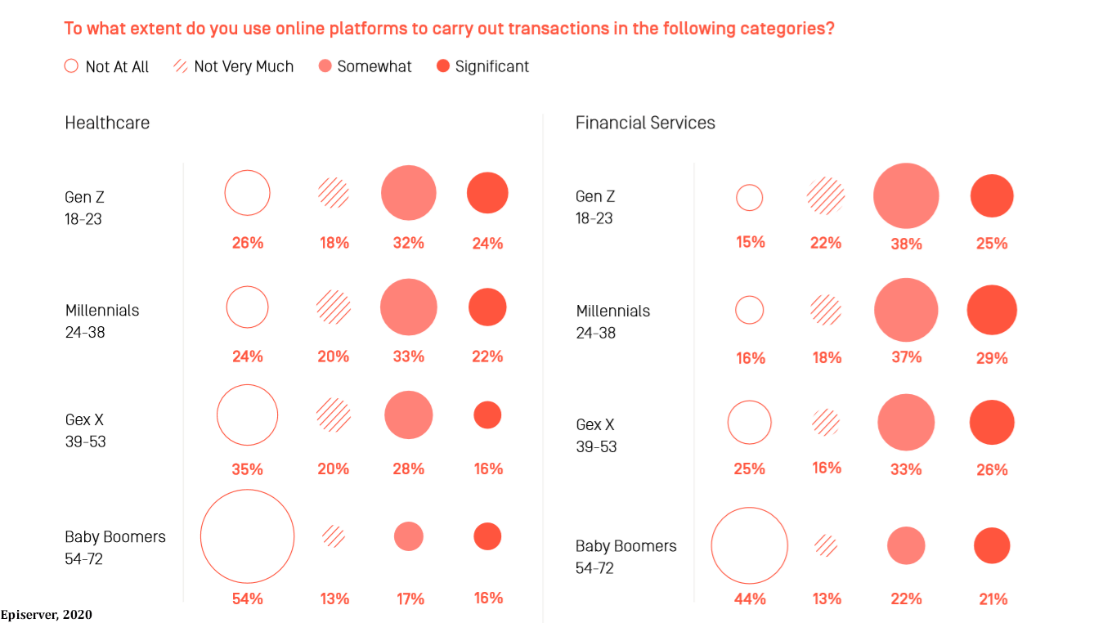Digital experience trends in healthcare marketing
Pre-COVID-19, when was the last time you made a doctor’s appointment, checked on a referral, accessed your records, paid a medical bill, ordered medical supplies, sought services or refilled a prescription, underwent some testing and thought, “Wow that was just a really great experience?”. Chances are, it’s closer to “never” than “always.”

Amberly Dressler

Today, companies are scrambling to be digital first not for the sake of experience but for the sake of everyone's safety. Personally, I had a virtual doctor's visit this week and actually thought, "wow that was convenient." My doctor adapted and it served both our needs.
Pre-COVID, healthcare was something that we as consumers had more patience for than other areas of our lives. We’ve come to expect frustrating, time-consuming processes. As digital-first generations take charge of their healthcare and the healthcare of their families, however, patience was already running out. Since we are keen to protect our families even more to meet basic needs during these times, patience is non-existent. In some cases - like where I am in California - we are ordered to stay home so needs must be met digitally.
The expectations consumers have for retail-like experiences such as self- and virtual service, online transactions and personalized content are impacting every industry. As if the consumer-facing experience wasn’t enough pressure, healthcare organizations also face demands from their buyers, expecting that same retail-like experience as they conduct business transactions.
Let’s look at three digital experience trends in healthcare marketing we discovered pre-COVID but are amplified now.
1. Virtual healthcare service
There’s no industry not impacted by our desire to do more, ourselves. It’s also becoming increasingly obvious that organizations must have a digital infrastructure in place to provide virtual healthcare service to consumers who want the convenience of opening their browser and getting everything they need without walking in a brick and mortar or dialing a number. The same is true for business buyers.
The desire to self-serve is years in the making while the desire to get virtual healthcare service has ballooned overnight in the wake of the COVID-19 global pandemic. Virtual doctor visits could, for example, limit the spread of the virus while an online “symptom checker” could calm fears. For businesses, having confidence in their healthcare partners to deliver the materials they need, can be addressed through self-serve and virtual options.
Once seen as an “IT thing” healthcare marketers must work with their IT counterparts to drive digital experiences that make a real-world impact. In the wake of COVID-19, we’re aware of some public healthcare organizations – hit hard with traffic to websites they host on their own environments – moving urgently to our scalable, cloud-hosted platform. With the right infrastructure in place, marketers can make digital experience upgrades that both consumers and businesses demand.
2. Online healthcare transactions
In Episerver’s survey of more than 4,000 online shoppers from around the world, people transact online with healthcare companies nearly as much as they do with financial services companies.

In fact, over 50 percent of those 18-38 years old carry out online transactions with healthcare companies. While those over 39 years old are slower to adopt online platforms for healthcare transactions, more digital experience options in healthcare marketing would accelerate adoption.
As service providers, commerce is low or missing on the priority list for public service and healthcare organizations. In 2020, healthcare organizations must consider online transactions a core part of their business readiness for both consumers and their business partners. Online transactions could be paying for records access, ordering supplies, paying insurance premiums, subscribing to wellness plans, using delivery services, signing up for virtual doctor visits and the list goes on. The opportunity in healthcare ecommerce extends to B2B ecommerce as well.
In fact, with the global COVID-19 pandemic, healthcare organizations that have not invested in ecommerce may struggle with inventory clarity, call center volume and the ability to identify and react to usage and demand changes.
Product education is part of this complex healthcare digital experience puzzle. Episerver customer Coloplast, a medical devices manufacturer, entered their next stage of digital readiness with a more streamlined process of managing and launching a multilanguage site to serve 50 countries worldwide with the web and product content needed for the diverse audiences.
3. Personalized content
Financial services and healthcare organizations are the “who’s who” of data compliance and security regulations – as they should be. These verticals represent companies with our most precious personal information. The intense level of data that some healthcare organizations possess can create conflict about using customer data to improve a customer’s digital experience.
Consumers themselves are conflicted on the matter. In Episerver’s previously mentioned survey, 62 percent of respondents indicated they feel that companies should place the same priority on personalized experiences in 2020 as they did in 2019. At the same time, 25 percent of consumers feel that brands should make respecting their anonymity online a higher priority. For healthcare organizations, there is a solution.
For starters, explicit consent is a must. Secondly, some misconceptions about data usage should be cleared up. To give consumers and business partners a personalized experience – one in which content and product recommendations reacting to a person’s priorities – doesn’t mean using their financial or health profile. Rather, it’s reacting to what they read.
Our colleagues at Idio like to say “you are what you read.” Content is a critical component in today’s healthcare marketing strategy. People are “always on” as another saying goes and are consuming content at a rapid clip to inform themselves in order to make decisions for themselves, their families and their businesses. For healthcare organizations, content marketing improves brand awareness, engagement, lead generation, patient loyalty and lead nurturing according to a True North Custom survey.
Healthcare marketers not yet adopting personalized content to improve a customer or business partner’s digital experience are not alone but will be if they don’t act quickly. According to a survey of 50-plus healthcare marketing executives, leveraging marketing automation to personalize and distribute content is a priority with 76 percent of respondents saying they are currently working on it or will within six months.
Episerver customer Laerdal Medical knows this, for example, as the digital experience for a purchaser (i.e., hospital procurement department) should differ greatly than a trainer (i.e., needing to know how to set up and fix products). Laerdal Medical uses Episerver to customize those experiences to connect visitors with the right solutions for their particular needs, complete with commerce functionality.
Digital experience in healthcare
As a global community, we’re only at the beginning of the incredible improvements that technology can bring to patient care and communication and empowering the now-burdened healthcare ecosystem with the digital ease found in other verticals. While it might be surprising that some of the pressure to digitize business operations is coming from consumers’ experiences in the retail sector, the investments healthcare marketers make in their digital experience strategy can have the most positive real-world impacts in this new normal.
